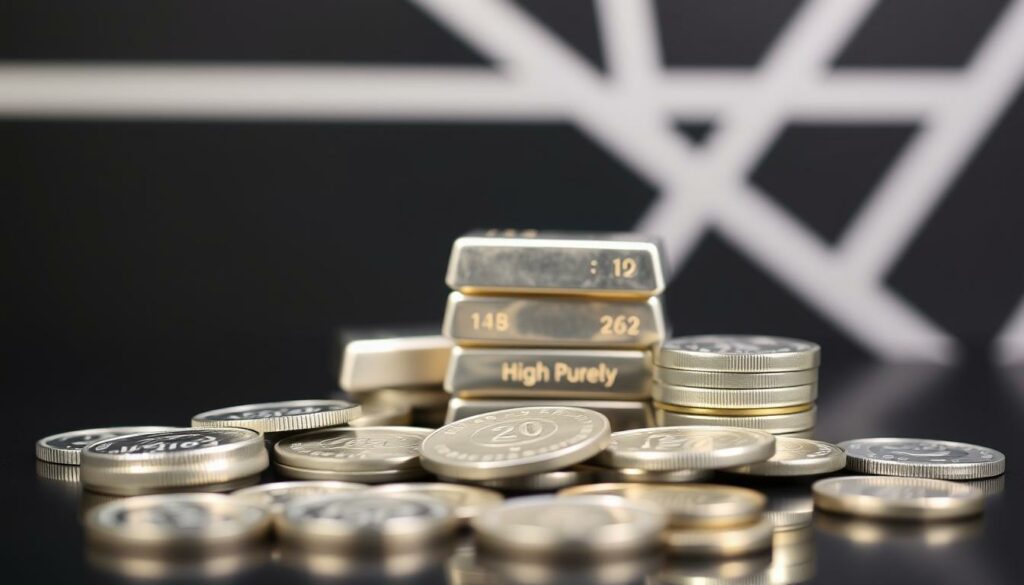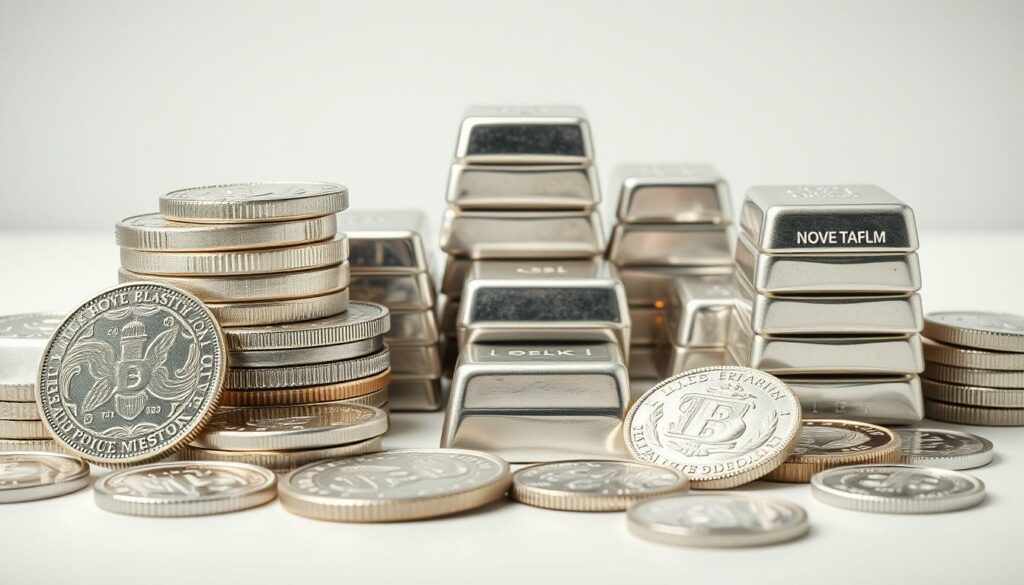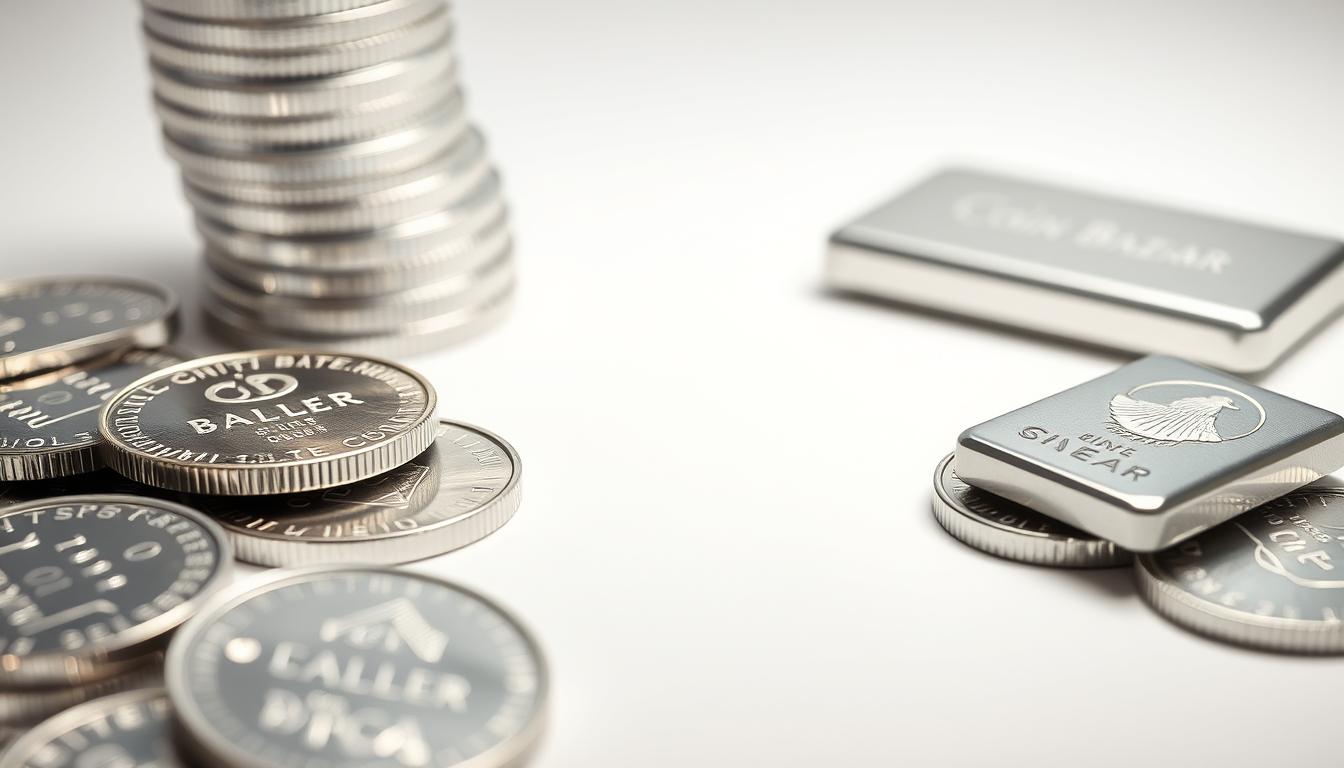Exclusive Deals & Trending Items


Precious Moments Personalised BIS Hallmarked Happy Parents Day Silver Coin Of 20 Gram in 999 Purity / Fineness By ACPL
Shop NowDeciding between silver coins vs silver bars is crucial for a wise physical precious metals portfolio. Silver is more affordable, priced at $25 per ounce, compared to gold’s $2,100. This makes silver a great choice for investors in India.
Coins come in various sizes, from 1/10 oz to 1 kg, offering flexibility. Bars, on the other hand, are cheaper for those buying in bulk. This guide will help you choose what fits your investment goals, considering taxes and storage.
Key Takeaways
- Coins excel for small, liquid investments with sizes as tiny as 1/10 oz.
- Bars cut costs by 5%+ per ounce when bought in bulk, ideal for large sums.
- Coin premiums stay lower than bars for mass-produced options like the Britannia or Maple Leaf.
- Coins avoid some taxes in regions like the UK, but check local rules for your area.
- Bars need secure storage for larger sizes, while coins fit home safes easily.
Understanding the Silver Investment Landscape in India
Investing in silver assets is becoming popular in India. It’s driven by cultural ties and economic trends. Silver is seen as a safe value and a way to protect against inflation. This makes it a top choice for bullion investments.
The Growing Popularity of Silver Investments
Silver demand in India has doubled in recent years. Prices have hit record highs, like ₹1,00,000/kg in 2024. It’s more affordable than gold, so people can buy more with the same money.
Analysts at Motilal Oswal think prices could go up to ₹1,25,000/kg soon. This is because of growing demand in industries like solar energy and electronics.
Cultural Significance of Silver in India
Silver has been important in Indian culture for centuries. It symbolizes wealth and spirituality. Families keep jewelry and coins for generations, mixing tradition with modern investing.
Even today, silver is valued during weddings, festivals, and religious events. 

Market Trends Affecting Silver Prices
Industrial demand plays a big role in silver prices. It’s used in solar panels, batteries, and medical technology. This steady demand keeps prices stable.
Hindustan Zinc’s solar-powered refinery shows India’s commitment to sustainable mining. Global economic changes, inflation, and political tensions also affect prices. So, it’s important to do market research for bullion investment options.
Silver Coins vs Silver Bars: Key Differences


When deciding between silver coins and bars, it’s important to know their physical differences. Coins have detailed designs and engravings thanks to minting. Bars, on the other hand, have simple shapes and are cast or stamped.
This difference in making affects their cost and value when sold.
Physical Characteristics and Manufacturing Process
- Silver coins: Made using high-pressure minting, ensuring detailed designs and collectible appeal.
- Silver bars: Produced through casting or stamping, prioritizing purity over artistic detail.
Typical Sizes and Weights Available
Silver coins usually come in sizes like 1 oz or 1/10 oz. Bars, however, come in a wide range, from 1 gram to 100 oz. For example, a 100g bar can hold more silver than ten 10g coins, saving space.
Purity Standards and Markings
Both coins and bars are usually 99.9% pure. Coins like the Indian Good Delivery Silver Coins or Maple Leafs have mint stamps to prove they’re real. Bars from places like PAMP Suisse or Johnson Matthey have serial numbers and assay certificates for proof.
“The choice between silver coins vs silver bars depends on whether you prioritize portability or bulk storage efficiency.”
When looking at silver prices, coins cost more because of minting. A 1 oz bar might be 5% more than spot price, while a 1 oz coin could be 10–15% more. Even smaller coins like 1/10 oz have higher markups. Always check the purity and the seller’s guarantee before buying.
Advantages of Investing in Silver Coins
Investing in silver coins has many benefits. They offer liquidity, versatility, and the chance for growth. For example, coins like the UK’s Britannia or American Eagles have premiums that reflect their value and collectibility. They are great for beginners, with prices starting at just $37.19.
Coins are backed by governments, ensuring their purity and weight. This is different from gold bars, which can be more expensive. Silver coins are also easier to store because of their smaller size and standardized weight.
| Factor | Silver Coins | Silver Bars |
|---|---|---|
| Liquidity | High (globally recognized) | Moderate (larger transactions needed) |
| Purity | Guaranteed by mints | Depends on producer |
| Cost per Ounce | Higher premiums | Lower premiums |
| Storage | Compact and stackable | Requires secure vaults for large holdings |
Collectible coins, like those from historic years, can increase in value. This makes them valuable for both collecting and investing. They also play a role in industries like EVs, which use silver in their production.
Coins are a good choice for starting a portfolio. They are easy to get into and offer flexibility. Whether you’re looking for quick gains or long-term investments, coins are a versatile option.
Benefits of Choosing Silver Bars for Investment
Exploring bullion investment options, silver bars are a smart pick for those looking to save money and be efficient. These investing in silver assets
Lower Premium Over Spot Price
Big silver bars, like 100 oz or 1 kg, have premiums as low as 2.6%. This is much less than the 20%+ margins on coins. For instance, a 1,000-oz LBMA-approved bar costs only 6.7% over spot. Meanwhile, 5-gram coins can have over 300% premiums.
This makes bars great for buying in bulk. You can put more money into pure silver content.
Space-Efficient Storage Options
- 1 kg bars take up 1/100th the space of coins of the same value (e.g., 100x 10g coins vs. a single 1kg bar).
- Professional vault services like Brinks or SBI Safe Custody offer secure storage for high-value holdings at 0.5-1.5% annual fees.
- Stackable designs and standardized shapes let you store $50,000 in silver in a briefcase-sized space.
Suitability for Larger Investments
Bars over 1 kg are perfect for serious investors looking to invest big. LBMA-accredited brands like Metalor and PAMP Suisse ensure global recognition. This makes it easy to sell in international markets.
Their standardized weights (100 oz, 1 kg) match institutional trading standards. This provides liquidity unmatched by gold ETFs. For portfolios over ₹5 lakh, bars cut costs by up to 70% compared to coins. Plus, Singapore’s VAT exemptions make these bars tax-efficient for cross-border investors.
Pricing Factors: Understanding Premiums and Markups
When you buy silver, it’s key to understand premiums. This helps you save money. Let’s look at what affects your costs:
Why Silver Coins Often Carry Higher Premiums
- Coin premiums usually range 15-20% over spot price due to minting costs and collectible appeal.
- Coins like the US American Silver Eagle or Canadian Maple Leaf include production fees and brand premiums.
- During crises, like 2008, premiums can spike to +80% due to scarcity and panic buying.
How Dealer Margins Affect Your Investment
When buying silver online, compare prices carefully. Local jewelers often charge more than online platforms:
| Dealer Type | Premium Range |
|---|---|
| Local Jewelers | 12-25% |
| Online Bullion Dealers | 8-15% |
| Government Mints | Fixed $2/oz seigniorage fee |
eBay sellers add 10% listing fees for bulk sales, raising effective costs.
Impact of GST on Silver Purchases
In India, GST adds 3% to silver purchases. This tax applies equally to coins and bars. But, smaller units like 10g coins face higher premiums per gram than 1kg bars. Always check silver pricing comparison tools to track total costs after taxes and fees.
“Premiums aren’t just about metal—storage, insurance, and dealer competition all shape your final cost.”
Remember: Bigger purchases often have lower per-gram premiums. Use buying silver online platforms to compare quotes from licensed dealers. This helps minimize markup surprises.
Liquidity Considerations When Selling Your Silver
When investing in silver assets, knowing how easily you can convert your holdings into cash matters. Silver coins often sell faster than bars due to their wide recognition. Let’s break down what affects liquidity for silver coins vs silver bars in India.
Coins like the Indian Good Delivery silver coins or global favorites like American Silver Eagles are widely accepted. Their standardized purity (99.9%) and government backing make them easier to trade. Bars, especially larger ones, may need specialized buyers or require splitting into smaller units to sell. Here’s a quick comparison:
| Liquidity Factor | Silver Coins | Silver Bars |
|---|---|---|
| Recognition | High (globally recognized mints) | Moderate (depends on purity and size) |
| Resale Premium | Lower spreads due to demand | Higher risk of discounts for bulk sales |
| Storage Efficiency | Less space for same value | More compact but harder to split |
Small denominations (1 oz coins) sell faster than 100-oz bars. To maximize returns:
- Sell through trusted dealers like MMTC-PAMP or Silver Bullion India.
- Check platforms like Zebpay or CoinDCX for digital sales.
- Avoid selling during market dips; track prices at sites like MoneyControl.
Remember: Coins trade like cash in emergencies, while bars work best for long-term holds. Always verify purity certificates and opt for brands like PAMP Suisse or RBI-approved issuances to ensure top liquidity.
Collectible vs Investment Silver: Making the Right Choice
Deciding between numismatic coins vs bullion bars depends on your goals. Collectible coins have unique benefits. Bullion, on the other hand, is great for pure metal investment. Let’s explore the options to guide your choice.
Numismatic Value Explained
Numismatic value is more than just the silver content. It’s influenced by:
- Rarity and limited mintage runs
- Historical or cultural significance
- Condition and preservation quality
- Design popularity among collectors
Popular Collectible Silver Coins in India
Indian investors often look at these collectible options:
| Coin Name | Mint | Key Features |
|---|---|---|
| Republic of India Commemorative Coins | India Government Mint | Issued for historical events like 75th Independence anniversary |
| 1 Oz Silver American Eagle | US Mint | Iconic design with annual mintage limits |
| Good Delivery Silver Bars | London Bullion Market Association | Global recognition for pure silver investment |
When to Prioritize Bullion Value Over Collectibility
Choose bullion if:
- You prefer collectible vs investment silver simplicity
- Storage space is limited
- Budget constraints require cost efficiency
Bullion bars and coins, like the Good Delivery option, have low premiums and pure silver. They are easy to sell globally at market rates.
Storage and Security: Protecting Your Silver Assets
Keeping your physical precious metals safe is crucial. It helps keep their value and gives you peace of mind. Whether you have silver coins or bars, taking care of them is essential. Here’s how to keep your investing in silver assets safe and in great shape.
- Home Options: Use a fireproof safe with a combination lock for smaller collections. Store silver in a cool, dry place (60–70°F, under 50% humidity) to avoid tarnishing.
- Bank Lockers: Many banks in India, like SBI or HDFC, offer lockers. They’re secure but you need to access them by schedule. Adding insurance gives extra protection.
- Professional Vaults: Third-party storage providers offer 24/7 surveillance and climate control. Fees vary, but they protect large amounts from theft and disasters.
Bars save space—stack 100 oz bars vertically. Coins fit neatly in Monster Boxes, which hold 500 coins like American Eagles. Use anti-tarnish cloths and silica gel packets to keep silver shiny. Always wear gloves to avoid oils damaging surfaces.
“Regular inspections and climate control extend the lifespan of silver investments.”
Insure your holdings through policies covering theft and damage. Check bank locker terms for included coverage. Professional vaults often bundle insurance with storage fees. Regular checks every 6 months ensure no damage or loss.
Whether stored at home or in a vault, smart storage keeps your physical precious metals safe and ready for growth.
Where to Buy Silver in India: Trusted Sources
Start by looking for licensed dealers with good reputations when buying physical precious metals. Sellers like MMTC-PAMP in India offer products with guaranteed purity. They have 99.5% pure silver bars and coins with assay certificates and serial numbers.
Reputable Dealers and Retailers
- MMTC-PAMP stores in major cities offer 100% assured buyback programs.
- Choose LBMA-accredited brands for authenticity.
- Ask for purity certificates and compare prices to avoid overpaying.
Online Platforms for Silver Purchases
For buying silver online, MMTC-PAMP’s official website is a good choice. They accept UPI, debit/credit cards, and need PAN details for big transactions. Always check delivery terms and packaging for security.
Avoiding Counterfeits and Scams
Verify every purchase with three steps: inspect certification, test specific gravity, and confirm government seals.
Coins like Sovereigns or bars from known mints have detailed engravings to spot fakes. Be wary of sellers offering prices way below market rates. For bars, check serial numbers against the maker’s database.
Tax Implications for Silver Investors in India
Knowing about taxes is key when investing in silver assets. This guide explains how taxes work for buying and selling silver in India.
Capital Gains Tax on Silver Sales
Taxes on selling silver depend on how long you held it:
- Short-Term Gains (held for less than 2 years): You pay taxes based on your income tax rate. For example, a ₹50,000 investment sold after 2 years is taxed as regular income.
- Long-Term Gains (held for 36 months or more): You pay a flat rate of 20.8% (including cess). For instance, a ₹10,000 profit is taxed at ₹2,080.
| Type | Tax Rate | Example |
|---|---|---|
| Short-Term | Income tax slab | ₹50k investment: 30% tax for higher earners |
| Long-Term | 20.8% fixed | ₹10k gain = ₹2,080 tax |
Wealth Tax Considerations
Silver investments aren’t taxed as wealth tax since 2015. But, big investments might need to be reported in tax filings. Always check with a tax advisor to make sure you follow the rules.
Documentation Requirements
Keep these records for audits and filings:
- Purchase invoices with GST (3%) and HSN code 7106
- Authenticity certificates for bullion investment options
- Transaction records for ETF investments (subject to STCG rules)
Always keep GST invoices showing 3% tax on purchases. Silver ETFs launched after 2022 are taxed as short-term gains right away. Keep up to date to get the best tax benefits!
Diversifying Your Precious Metals Portfolio
Building a strong diversifying with precious metals strategy starts with mixing different types of silver and other metals. Physical precious metals like coins and bars are the foundation. Adding gold, platinum, or palladium adds extra protection. Start with silver coins for easy access, and add bars for more savings.
- Combine silver coins (for liquidity) with gold for long-term stability.
- Include platinum or palladium to capitalize on industrial demand trends.
- Allocate 5–15% of your portfolio to physical metals to balance market risks.
Major world governments hold large quantities of physical metals as a hedge against economic downturns, indicating their importance in financial stability.
Platinum and palladium have unique values because of their industrial uses. Even a small amount of these metals can boost your returns. Mix physical assets with ETFs for more diversification, but always prioritize owning real items you can store safely. Remember, a 10% allocation to one asset limits maximum loss exposure to 10% of your total portfolio.
Begin with silver coins and grow into gold or other metals as your budget increases. Check your mix every year to keep up with market changes and your goals. The right mix of physical precious metals with stocks or real estate protects against inflation and market swings.
Silver as a Hedge Against Economic Uncertainty
When economic storms hit, silver can protect your wealth. It serves as both an industrial material and a store of value. This makes it a flexible tool for any portfolio. Let’s explore how it guards against market shifts and inflation.
Historical Performance During Economic Downturns
History shows silver shines during crises. During the 2008 financial crash and the 2020 pandemic, prices jumped. Investors sought stability.
In India, silver often outperformed when inflation spiked. This was true during the 1970s oil crisis and recent years. Its volatility means it can rebound sharply when demand surges.
Understanding the Silver-to-Gold Ratio
The ratio compares silver’s price to gold’s. It helps you spot opportunities. When the ratio is high, silver may be undervalued.
For instance, during the 2020 crisis, this ratio hit extremes. This signaled buying chances. Monitoring it lets you balance diversifying with precious metals.
Protecting Against Currency Devaluation
Currency weakness? Silver’s role in investing in silver assets helps. When inflation erodes cash value, silver often rises. Its ties to tech and green energy demand add real-world value.
Platforms like OWNx let you own fractions of silver. This makes it easy to shield savings without physical storage. It’s a practical choice for safeguarding wealth during economic uncertainty.



















